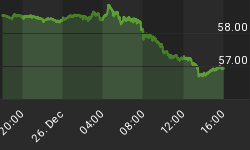The lower Bollinger bands are well beneath the index, suggestive a bottom is in. The upper Bollinger bands are declining to meet the index, so at least 3-4 months of consolidation should be expected before the XOI heads to new highs. The short-term stochastics has the %K above the %D, suggestive the current rise has 2-3 more weeks prior to a top.
Figure 1
The moving averages are in bullish alignment (50 day MA above the 155 day MA above the 200 day MA), with the 50 day MA acting as support and the 200 day MA acting as resistance. Blue lines on the right represent Fibonacci price retracements of the advance from early summer until the September top. Red lines represent Fib price extensions of the move from late 2003 until March 2005 (this fits with the Elliott Wave count of the index. The 61.8% level of the decline was hit with the bottom and is likely in a consolidation pattern for the next 4-6 months. If wave [3] in the XOI starts around April/May 2006, a move to 1560 could minimally be expected (1.618x wave [1]). The full stochastics have the %K beneath the %D within an expanding wedge pattern. The %K appears to be slowly setting up for a reversal, although nothing conclusive as yet. The %K could proceed to hit the lower trend line or cross above the %D, only time will tell. The Fib time extensions has May 31 2006 as the near termination point of wave II, which coincides well with an April/May 2006 bottom in the XOI.
Figure 2
The weekly XOI is shown below. Fib time extensions places the end of wave II (1:1 ratio of the current correction underway since Aprilish 2005 with the initial advance in the XOI. The lower 55 MA Bollinger band is at 577 and slowly rising; however a consolidation to May/June 2006 should pose enough time to rise to near the index value before the next phase in the oil bull market begins. The stochastics as per Figure 2 also have an expanding wedge pattern with the %K beneath the %D. On the weekly chart, the XOI still looks bearish, with at least 6 more months of consolidation required prior to the next upleg.
Figure 3
The long-term Elliott Wave count of the XOI is shown below. The initial starting point for the wave count was shifted to the right and the termination point of wave [1] was changed, because the extended wave was developing too long relative to the other wave structures. What this pattern suggests is that wave [X] which formed this summer is the second leg of a running correction, with a triangle now forming for wave (Y). A triangle has 5 legs and currently the second leg (wave B) is underway). A move to 1050-1060 in the XOI is expected prior to reversing lower, but remaining above the low of wave A. Note: the triangle likely forming at present could be a rising triangle or a contracting triangle at present levels. The important take home message is the consolidation should at least last until early March.
Figure 4
The short-term Elliott Wave count of the XOI is shown below. Wave (W) was a double flat combination, wave (X) was a zigzag and wave (Y) Is likely developing into a triangle that will not complete until April/May 2006.
Figure 5
The prior corrective wave structure for the XOI was 5 ½ years, and the XOI has been in a bull market by the current count for nearly two years; so there is at least 3 ½ years left which puts us to the time frame of early 2009 and is right in line with my expectations. The HUI is following a longer-term wave count than the XOI so a top is not likely to occur until 2011. This makes sense, because at that point, the USD will be in decline and people will be scrambling to try and preserve whatever capital they have left. Those are my thoughts for today.
The S&P 500 Index count presented nearly one month ago finished shy of early November, but 1070 held and is now rallying to approximately 1260.The rally should last until mid-December. I also track the US Dollar Index, the AMEX Gold BUGS Index and the 10-Year US Treasury Index. The TNX has proven to be a difficult beast to count, with lower accuracy relative to the other indices I follow. Select stocks are also mentioned for accumulation.
















